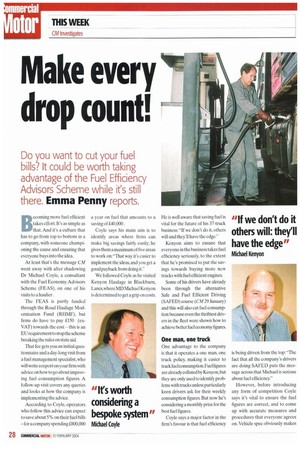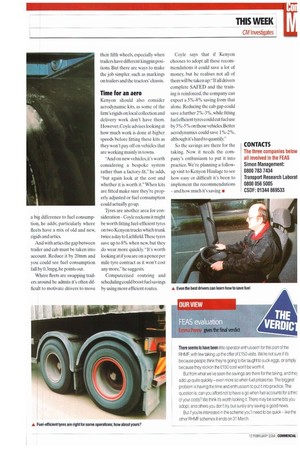Make every drop count!
Page 28

Page 29

If you've noticed an error in this article please click here to report it so we can fix it.
Do you want to cut your fuel bills? It could be worth taking advantage of the Fuel Efficiency Advisors Scheme while it's still
there. Emma Penny reports.
Becoming more fuel efficient takes effort. It's as simple as that. And it's a culture that has to go from top to bottom in a company, with someone championing the cause and ensuring that everyone buys into the idea.
At least that's the message CM went away with after shadowing Dr Michael Coyle, a consultant with the Fuel Economy Advisors Scheme (FEAS), on one of his visits to a haulier.
The FEAS is partly funded through the Road Haulage Modernisation Fund (RIIMF), but firms do have to pay £150 (exVAT) towards the cost — this is an EU requirement to stop the scheme breaking the rules on state aid.
That fee gets you an initial questionnaire and a day-long visit from a fuel management specialist, who will write a report on yourfirm with advice on how to go about improving fuel consumption figures. A follow-up visit covers any queries and looks at how the company is implementing the advice.
According to Coyle, operators who follow this advice can expect to save about 5% on their fuel bills — for a company spending £800,000 a year on fuel that amounts to a saving of £40,000.
Coyle says his main aim is to identify areas where firms can make big savings fairly easily; he gives them a maximum of five areas to work on: "That way it's easier to implement the ideas, and you get a good payback from doing it."
We followed Coyle as he visited Kenyon Haulage in Blackburn, Lancs,where MD Michael Kenyon is determined to get a grip on costs. He is well aware that saving fuel is vital for the future of his 37-truck business: "If we don't do it. others will and they'll have the edge."
Kenyon aims to ensure that everyone in the business takes fuel efficiency seriously, to the extent that he's promised to put the savings towards buying more new trucks with fuel efficient engines.
Some of his drivers have already been through the alternative Safe and Fuel Efficient Driving (SAFED) course (CM 29 January) and this will also cut fuel consumption because even the thriftiest drivers in the fleet were shown how to achieve better fuel economy figures One man, one truck One advantage to the company is that it operates a one man, one truck policy, making it easier to track fuelconsumption.Fuelfigures are already collated by Kenyon,but they are only used to identify problems with trucks unless particularly keen drivers ask for their weekly consumption figures. But now he's considering a monthly prize for the best fuel figures.
Coyle says a major factor in the firm's favour is that fuel efficiency is being driven from the top: "The fact that all the company's drivers are doing SAFED puts the message across that Michael is serious about fuel efficiency."
However, before introducing any form of competition Coyle says it's vital to ensure the fuel figures are correct, and to come up with accurate measures and procedures that everyone agrees on. Vehicle spec obviously makes a big difference to fuel consumption, he adds: particularly where fleets have a mix of old and new, rigids and artics.
And with artics the gap between trailer and cab must be taken into account. Reduce it by 20mm and you could see fuel consumption fall by 0.3mpg, he points out.
Where fleets are swapping trailers around he admits it's often difficult to motivate drivers to move their fifth wheels, especially when trailers have different kingpin positions. But there are ways to make the job simpler. such as markings on trailers and the tractors' chassis.
Time for an aero Kenyon should also consider aerodynamic kits, as some of the 1 irm's rigids on local collection and delivery work don't have them. However,Coyle advises looking at how much work is done at higher speeds before fitting these kits as they won't pay off on vehicles that are working mainly in towns.
"And on new vehicles, it's worth considering a bespoke system rather than a factory-fit," he adds, -but again look at the cost and whether it is worth it." When kits are fitted make sure they're properly adjusted or fuel consumption could actually go up.
Tyres are another area for consideration-Coyle reckons it might be worth fitting fuel-efficient tyres on two Kenyon trucks which trunk twice a day to Lichfield.These tyres save up to 8% when new, but they do wear more quickly. "It's worth looking at if you are on a pence per mile tyre contract as it won't cost any more," he suggests.
Computerised routeing and scheduling could boost fuel savings by using more efficient routes. Coyle says that if Kenyon chooses to adopt all these recommendations it could save a lot of money. but he realises not all of them will he taken up:"If all drivers complete SAFED and the training is reinforced, the company can expect a 5%-8% saving from that alone. Reducing the cab gap could save a further 2%-3%, while fitting fuel efficient tyres could cut fuel use by 3 %-5 % on those vehicles. Better aerodynamics could save 1%-2%, although it's hard to quantify."
So the savings are there for the taking. Now it needs the company's enthusiasm to put it into practice. We're planning a followup visit to Kenyon Haulage to see how easy or difficult its been to implement the recommendations and how much it's saving






























































































































































































